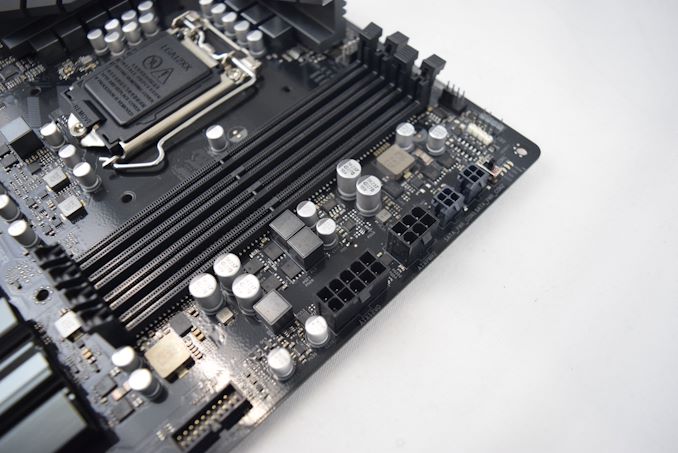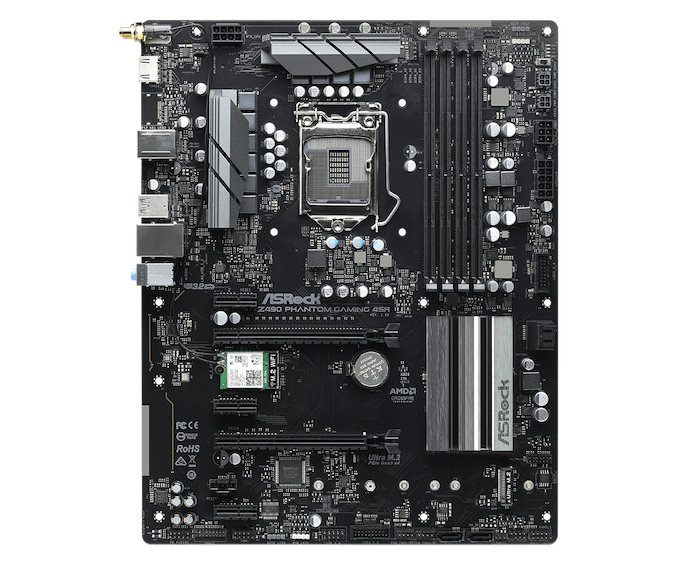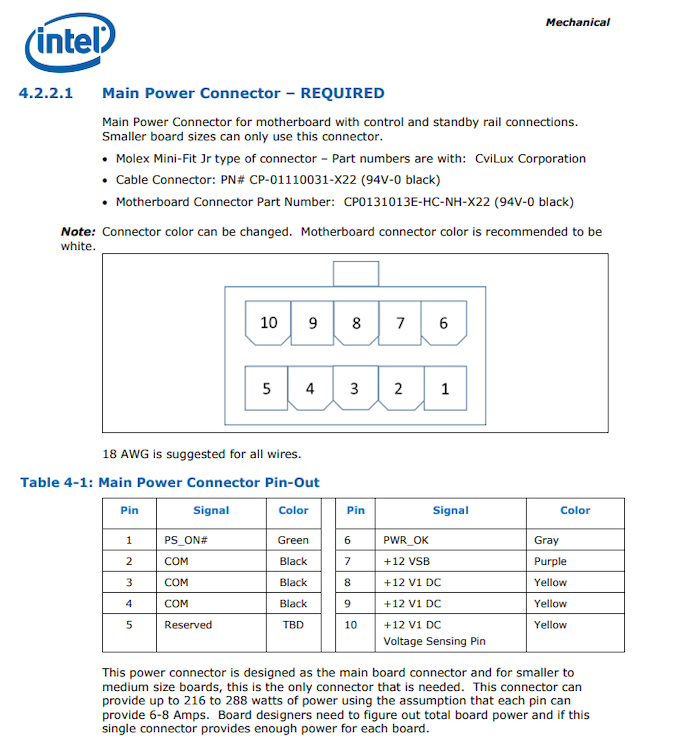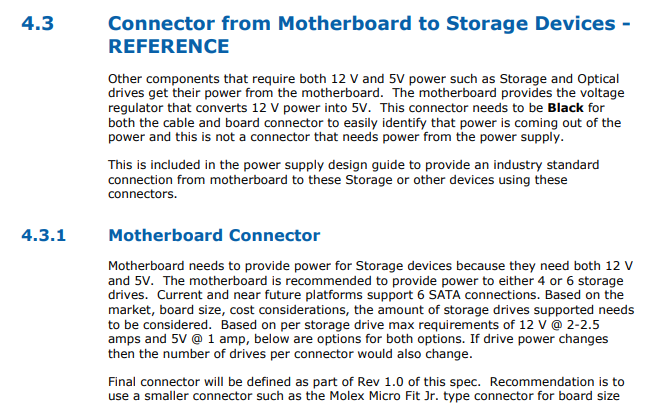First ATX12VO Consumer Motherboard: The ASRock Z490 Phantom Gaming 4SR
by Dr. Ian Cutress on May 5, 2020 12:00 PM EST- Posted in
- Motherboards
- Intel
- ASRock
- Z490
- ATX12VO

One of the biggest legacy characteristics of the modern PC is how the power supply connects to the motherboard – not only is it one big chunky 24-pin power connector in to the board, but it has to supply all of the relevant voltages, including 12 V, 5 V, and 3.3 V. Over the last two decades, standards that used 5 V and 3.3 V have almost disappeared, except for a last few legacy applications. Despite that, we’ve been lumbered with the old ATX12V standard for this. However recently the ATX12VO standard was announced, requiring only 12 V into the motherboard and other voltages to be derived from it on the board. This also allows the power supply to be more efficient and compact, with a smaller connector. At the time, given the ubiquity of the ATX12V standards, we were all under the impression that ATX12VO would be something for the embedded market, where the full hardware stack could be customized top-to-bottom. A blog post from Intel showcased the first consumer motherboard with the standard from ASRock, and we reached out to ASRock for more details. They have now put up a product page for this board, the ASRock Z490 Phantom Gaming 4SR.
Intel's Stephen Eastman, Platform Power Specialist
In Intel’s Blog Post, the company states that the new ATX12VO standard will help substantially with idle power of a PC, due to the single rail design not needing to cater for other voltages other than 12 V. The company states that governments will benefit a lot from this, given that the standard complies with upcoming standards for electronic efficiency in the US and Japan. It notes that while there have been single rail custom designs in the past, this new industry standard will allow vendors to unite under a single implementation. One of the key partners for this is ASRock, who state that they are Intel’s primary partner on this project.
On the face of it, the new ASRock Z490 Phantom Gaming 4SR looks very much like what a user should expect from a Z490 motherboard, with a socket, power delivery, PCIe slots, and other additional controllers. What makes it stand out is the power supply connection, as defined in the standard (or Intel reference manual).
The main power comes from the first 10-pin connector, which provides up to 288 W. For small and medium sized motherboards, this should be the only power that is needed.
Additional power for high-end motherboards that need it come from a 6-pin connector, which can provide another 288W.
Note that the 8-pin 12V CPU power is still required for the processor – the 10 pin (and 6-pin) here give power to the components on board, and the PCIe slots.
There are additional connectors for storage, for motherboards that need it. This is primarily for motherboards that use a lot of SATA connectivity, or use the motherboard to provide the power to the SATA drives or ODD units, which is particularly common in embedded systems. In the case of the ASRock board, we have four SATA connections and an M.2 slot.
What makes this perhaps a little strange is that although this new ATX12VO standard is aimed at the lower power parts of the market and the more embedded designs, ASRock has made this a full Z490 board. It supports overclocking and fast memory, it has better gold-pin plating in the DRAM slots, there’s an ALC1200 audio codec, 802.11ac Wi-Fi, and so on. That being said, the PCIe slot layout is only x16 from the CPU and x4 from the chipset, rather than an x8/x8 design.
As to when this motherboard goes on sale, we’re not quite sure – very likely it will be region limited as well. It depends on how well the power supply industry gets into gear with their ATX12VO products for consumers as well.

















47 Comments
View All Comments
Spunjji - Wednesday, May 6, 2020 - link
This post comes across as genuinely unhinged.Tomatotech - Thursday, May 7, 2020 - link
I’m quite happy to lose lots of SATA ports. With nvme becoming insanely fast, raiding disks for speed is dead dead dead. CD drives died years ago. DVD drives are dying if not already dead - almost nobody still uses them on laptops or desktops. 99% of people need no more than 2 sata ports - one for a big spinning rust drive, and the other one for another spinning rust drive to back it up.I’m in that 1% - I have 3x 4TB 2.5 drives in a tiny mITX case but I would be quite happy with just 2 x SATA ports. I’d rather have an extra nvme slot or 4 banks of RAM not the 2 banks I have at the moment.
ikjadoon - Saturday, May 9, 2020 - link
Completely agree. I think two SATA ports would be perfect for legacy hookups or connecting archival storage (i.e., updating the firmware of an HDD from a Linux-based NAS in Windows).The issue with nVME is the PCIe lane drought. Ideally with the next-generation chipsets & SSDs, I'd love to switch to x2 PCIe 4.0 and make two NVMe slots as the minimum.
1_rick - Tuesday, May 5, 2020 - link
The first time I heard of this new spec, "saving space with a smaller connector" was mentioned. I don't know how important a design goal was, but having to add back up to 2 6-pin and up to 2 4-pin connectors (plus not being able to get rid of the existing 8- and/or 4-pin ones for the CPU) kind of wrecks that idea. (sure, for motherboards that can get by without the need for those things it's a win, but I would think even cheap Dell motherboards will still need some of those extra connectors for the foreseeable future.TheUnhandledException - Wednesday, May 6, 2020 - link
The base connector support 288W. Add in an EPS 8 pin connector and that is 588W total. I don't know many boards that need more than that. Sure the spec supports UP TO two additional 6 pin PCIe connectors but that would be for a main board which requires 1,164W of power. So yeah maybe in a quad socket server board.Lakados - Tuesday, May 5, 2020 - link
OEM’s have been using proprietary versions of this for years in their efforts to meet power requirements regulations for government contracts. It was good for Intel to standardize it like the ATX format this borrows from. Neat that’s of all the brands ASrock is the first to get a consumer one to market. Hopefully they put out an mATX or an ITX version might be able to drop it into a bunch of old Dells I have kicking around.StrangerGuy - Tuesday, May 5, 2020 - link
Why a new 10-pin connector if we are going full +12V? Why not just make EPS12V-pin mandatory to power everything on the mobo, with a aux PCIE 8-pin on the mobo just for that 0.0001% of people who runs a OCed 9900K with a 75W slot powered only GPU?TheUnhandledException - Wednesday, May 6, 2020 - link
You need more than just power pins. The 10 pin connector is 6 pins for power (3 +12V, 3 ground). It then has a pin to turn the PSU on, a pin for the PSU to indicate power is good, and a pin for standby power (which has moved from 5VDC to 12VDC). So that is 9 pins. The 10th pin is currently unused.antonkochubey - Monday, May 11, 2020 - link
> The 10th pin is currently unused.Correction: in ATX12VO spec, it is used as optional voltage sensing pin (up to 10mA draw to prevent DC voltage offset)
edzieba - Wednesday, May 6, 2020 - link
Of /course/ it's the madlads at ASRock first out of the gate! Though a bit disappointing it's an ATX board and not ITX: the SFF world has been clamouring for (and self-implementing with plug-into-the-ATX-connector boards like the KMPKT Dynamo and HDPlex DC-ATX) 12V only operation, and ASRock have been excellent to the SFF market with plenty of unique boards like the barmy X299 ITX, or the absolutely insane EPC621D6I that crams LGA3647 onto an ITX board.